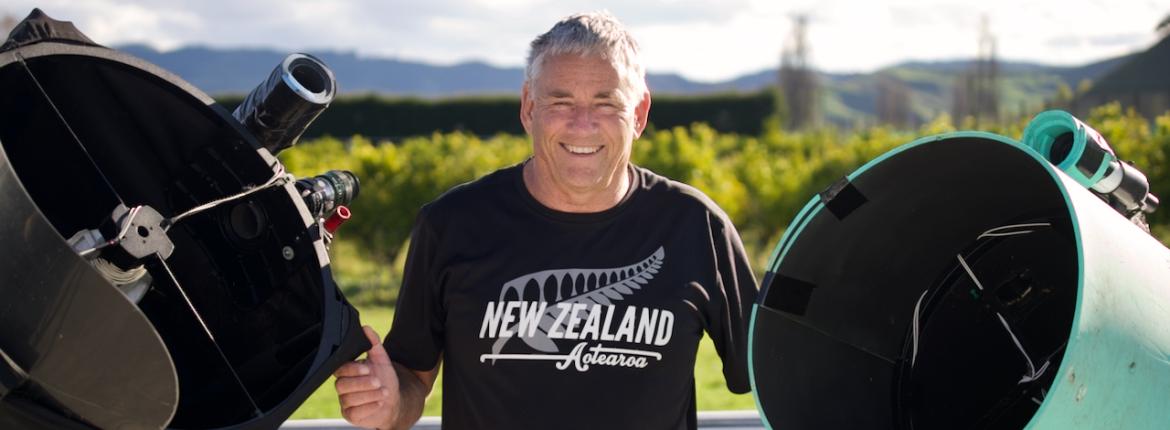John Drummond was star struck the first time he recognised a constellation in the night sky. The Tairāwhiti Gisborne surfer, science teacher, astro-photographer and highly qualified amateur astronomer was 10 when his mother pointed upwards one evening and showed her son how stars formed the shape of saucepan.
“Something went boom,” he says, describing that revelatory moment to the 15 visitors who have gathered inside his makeshift paddock classroom on a Saturday evening. “Once I saw the pot in Orion I was absolutely fascinated with astronomy from that moment on.”

The Moon and Jupiter captured by John Drummond.
We are a mixed bag of paying guests; eager adults and families with antsy children, with one obviously serious astronomy boffin in the audience and the rest of us willing stargazers with more curiosity than knowledge. The vast majority are local residents who have spotted one of John’s Gisborne Astro Tours signs and ventured to rural Pātūtahi to find out what happens in the cluster of blue-roofed sheds after dark
Wear warm clothes and gumboots, an advance email message recommends. The latter suggestion guards against wet grass and sheep poo, but my footwear also comes in handy when someone asks a question while we are assembled outside. John seizes my discarded boots and a pair of jandals to illustrate a particular planetary arrangement on the classroom deck.

John Drummond of Gisborne Astro Tours. Photo by Taylor Kirk.
The two-hour tour begins with a warm welcome and a presentation that includes a brief history of the universe as well as photos of the resident sheep. They are an ancient breed that hail from England’s Stonehenge area “so there’s an astronomical link with my sheep,” John says. He also demonstrates a trick that allows us to see ultraviolet light, using a cellphone and a television remote control. There is no question our teacher knows what he is talking about and there’s certainly no doubt about his passion. A recent past president of the Royal Astronomical Society of New Zealand, he already holds a Master’s degree in astronomy and is about to begin Doctorate studies.
According to his website, John’s astral images have been published in books and magazines around the world and even appeared on a couple of New Zealand stamps. He has also helped discover about 20 exoplanets, which we learn are planets that orbit around other stars.
As John spends his days engaging teenage school students, he easily captures and holds our attention. So, we learn there are more stars in the universe than grains of sand on all the beaches on Earth. We absorb the fact that light pollution prevents three quarters of the planet’s people from seeing the Milky Way galaxy. Go home and check your security lights, he tells us. Those lights are harming animals, too.
We discover the best time to see a specific meteor shower (Labour Weekend, around 4am) or the next lunar eclipse (November). And this gold ring I’m wearing? Apparently, the metal cannot be made on earth; it was formed by a supernova explosion.
Then, he leads us outside. The roof has been removed from the largest of his sheds to reveal three telescopes that point heavenwards, in different directions. Laser pointer in hand – yes, he has official permission to use it – he reveals more secrets of the universe. Navigation tales are told, pinpricks of blue or red are identified, globular clusters are named, satellites spotted and zodiac star signs are revealed.

Incredible shots of the galaxy captured by astronomer John Drummond.
Throughout the rest of the evening, our host moves between each telescope, positioning and re-adjusting to focus on different corners of sky or avoid a bank of clouds sweeping through.
Despite the unusually large group size, everyone has a chance to catch an eyeful as many times as they like, and there are plenty of delighted gasps as vague murky patches magnify to reveal bright individual beacons. In between, necks tip backwards and heads swivel as we marvel at everything the naked eye can see above a Pātūtahi paddock.
It is clear that decades of astronomy study have only increased John’s sense of awe. Nearby, a raised platform hosts his reclining chair. On special occasions such as a meteor shower he will connect an electric blanket, lie back and spend the entire night watching the sky.
Reported by Sue Hoffart for our Spring 2022 issue




